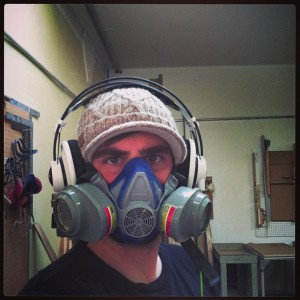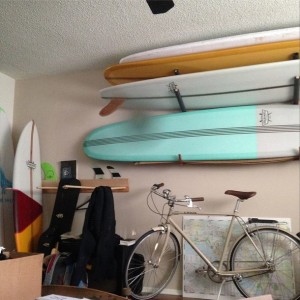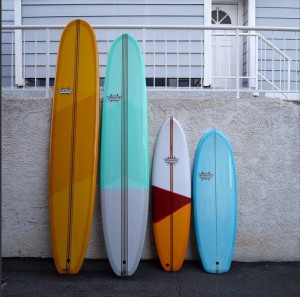
Drew Mason, Owner/Shaper of Mason Surf Designs
Edit: Drew has moved his crowdsourcing campaign to GoFundMe.
I’ve learned a lot on all of my interviews for the Creative Spaces series, but let’s be honest. I didn’t know a damned thing about surfing before sitting down with this handsome lad. Drew Mason of LA does more than design and shape surfboards, he bleeds surfing. Well, his wife hopes he doesn’t have to bleed, but the man loves the sport, the community, the gear, everything about the world of surfing. After 20 years riding waves, he’s not at all surprised to find himself building his own little, independent surf empire: Mason Surf Designs. At present, Drew’s workspace isn’t perfect or even entirely his own, which is why he’s launched an indiegogo to raise funds. “Some day in the hopefully not-too-distant future,” Drew tells me, “I hope to have a standalone surf shop where I can build and sell my boards and other products, and where surfers can come by to just hang out, talk, bounce ideas off of each other. I don’t even care if they aren’t there to shop.”
Drew took a break from his passion and the day job that currently helps support his passion to chat with me about surfing, shaping, creativity and his current Indiegogo campaign. This guy not only knows his stuff, he knows how to explain said stuff to a non-surfing Midwesterner. Guys, I even learned what hang 10 means — it’s when 10 toes hang over the nose of your surfboard!
That’s a good question — day to day I’m probably working on a different aspect of a board or the business, but I’m a shaper: I design templates and outlines for surfboards and then use those templates to shape the boards themselves out of foam.
Probably during my junior year of high school. I was competing on surf teams (those are a thing in California) and would hire this shaper to design custom boards for me. I always loved sitting in on the process and watching the boards be created. My shaper would let me shape my board with his guidance. It was funny, I was paying him to shape a board for me, but then I’d do the shaping sometimes. Anyway, it really just stuck with me that this was something I enjoyed and really wanted to do.
It’s actually typical. Within the surfing industry if you have the title of shaper it’s generally understood you’re doing the whole process. If a company gets too big for itself or has too many orders there may be more people manufacturing the boards. But they are based off of an existing design originally crafted and shaped by the shaper.
Symmetry.
The moment right after I’ve planed the block of foam into the shape of the board, but before I start fine sanding it. It’s the first hint at the vision coming together. It’s no longer a block of foam, it actually starts to look like the final product.
There is a process in the sense that every board is designed for a specific wave. There are waves that break over reefs, sanded beach breaks, rocks and then the coast line has it’s own affect. So the process is determind by where you are surfing, on what kind of waves. Once you determine that you can design the board with elements that will help the surfer in those specific conditions. When I do a custom board for someone I need to know their height, weight, skill level and, most importantly, where they are planning on surfing because that really effects how the board needs to be shaped.
For the computer it varies. If I have a really clear vision for the design, I can get it done quickly–like, easily under an hour. If I don’t have a clear direction at the outset, I’ll probably spend an hour, two tops playing until I find something that seems fun or interesting to try. Then I have to print and cut out the template before I can head to the shaping bay.
Shaping can take anywhere between 4-6 hours. It may not seem like a lot but it’s very gradual. On the computer, you have an undo button. You don’t have that with foam. It’s easy to strip away but you can’t just put it back.
The desk is such a minimal aspect of my process and it feels too formal to me. I don’t feel as creative sitting at a desk. Designing boards is kind of like writing a song, you want to write down the lyrics as they come. If I have an design idea in my head, I’ll do it wherever I am–sometimes I work on a design in my car when I’m on break. At home, I’ll work on the La-Z-Boy a lot, it feels less rigid. When I’m cutting out templates, I like to work on the balcony.
Right now, I’m shaping at a place called Shaper Supply in Venice Beach. Florian, the owner, has all of the materials and tools for people who want to do the process themselves at home. Then, if you don’t have space for it at home, he has two shaping bays he rents out.
I don’t fiberglass at home either, I take it down to Waterman’s Guild in Costa Mesa. I’ve been using them for years, and they are one of the best in the world for company and overall quality.
The white foam you’re shaping is really easy to see against blue. When you’re working on all of those little concaves or smoothing out bumps, if you’re looking down the white foam board at a blue wall, you can see the shadows better than if you were, say, working on a white wall with the white foam.
Not getting stuck in a rut. For me that means surrounding myself with people and things to keep creativity going: music, conversation, feedback, new tools. Don’t get me wrong, if you’re vibing on something keep going. I know Shapers who listen to the same album whenever they shape a certain kind of surfboard because that’s what gels and it helps keep their work consistent.
I consider myself an organized mess. Things have their place but it doesn’t mean it looks pretty. To me, organized means all of the tools I need for a specific phase of the process together and handy, nothing more.
They’d probably just get covered in foam dust.
It’d be a few spaces. A 10×20 foot shaping bay room, a separate creative room for working on templates or shaping fins–like a woodshop/workshop, a corner set up for product photography and then the storefront where I can actually meet and talk with surfers and customers face to face. I want to always be hearing what the community wants because my ideas are great for me, but may not be what others want to try.
The coveted surfboard planer is the Skill 100, but it’s not been manufactured for 20 or 30 years now so they are hard to come by. That’d be nice, but I can work with any tool, really. The major need is the space. give me a 50-year-old rusty hand plane and I can make a board, but I need the space first.
Mason Surf Designs. How it started and what it’s become.
Well, it started back in high school when my preferred Shaper taught me how to shape my own boards. Then, for years, I’d experiment and shape boards for myself. I realized I could shape every day and be perfectly happy and I love making boards for other people so I decided to dive in.
When I was trying to think of a name my friend Eric pointed out that my last name is pretty spot on, so why not just use my actual name. A lot of surf company’s use their Shaper’s name as a brand, but for me it seemed right because I love classic surf design and I have a classic craftsman name. I mean, a mason is a talented craftsman. I felt like it packed a double punch.
It’s called Egor’s, though other people would call it Terramar, in Carlsbad. That’s my favorite wave, it’s my homebreak. It’s sort of a unique spot with a slight point, reef break and a beach break all together. You can always find a wave there and it’s tucked away so it’s never crowded–more of a locals only spot so you know everyone surfing with you.
Agh, each is so different. If I can pick two, and I’m going to, I’d choose the Logger and the Woodsman. The Logger is an old 50’s style design, it’s just a solid, classic board, and the Woodsman is my go-to for nose riding.
 You can find Drew and his boards online at MasonSurfDesigns.com or IRL Los Angeles’ Surf Swap where a lot of Southern California surfers come together to chat and change up their gear. LA’s surf swap is relatively new and meets every three months. Drew personally tests each new design he adds to his stock to ensure they ride perfectly, so, if you catch him in the water, chances are high he’ll be paddling one of his own board designs–perfect time to check it out, buy it off of him or make a custom order. As a lover of the community and creativity of surfers, Drew is always happy to talk shop and is excited to be featured in an upcoming photoshoot by local Chicago action sports photographer, Teddy Hoffman. I’ll drop you a tweet when those photos are available online.
You can find Drew and his boards online at MasonSurfDesigns.com or IRL Los Angeles’ Surf Swap where a lot of Southern California surfers come together to chat and change up their gear. LA’s surf swap is relatively new and meets every three months. Drew personally tests each new design he adds to his stock to ensure they ride perfectly, so, if you catch him in the water, chances are high he’ll be paddling one of his own board designs–perfect time to check it out, buy it off of him or make a custom order. As a lover of the community and creativity of surfers, Drew is always happy to talk shop and is excited to be featured in an upcoming photoshoot by local Chicago action sports photographer, Teddy Hoffman. I’ll drop you a tweet when those photos are available online.
For more of his story and to contribute to his craft, check out Drew’s indiegogo campaign; perks include everything from high-end shirts to a custom board. You can like Mason Surf Designs on Facebook and follow Drew on Instagram @MasonSurfDesigns.
If you would like to be featured on the Creative Spaces series, please contact me.
Tagged with: carlsbad surf • costa mesa surf • creative spaces • custom california surfboards • custom surf la • custom surfboards • custom surfboards la • drew mason surf designs • handcrafted surfboards • independent creatives • independent surf • indie surf supply • indiegogo • los angeles surf swap • mason surf designs • one man surf shop • shaper supply • shaping bay california • surf design • surf design indiegogo • surf indiegogo • surfer indiegogo • surfing • surfing carlsbad • surfswap • surfswap la • teddy hoffman action photography • teddy hoffman photography • waterman's guild california
Comments are closed.